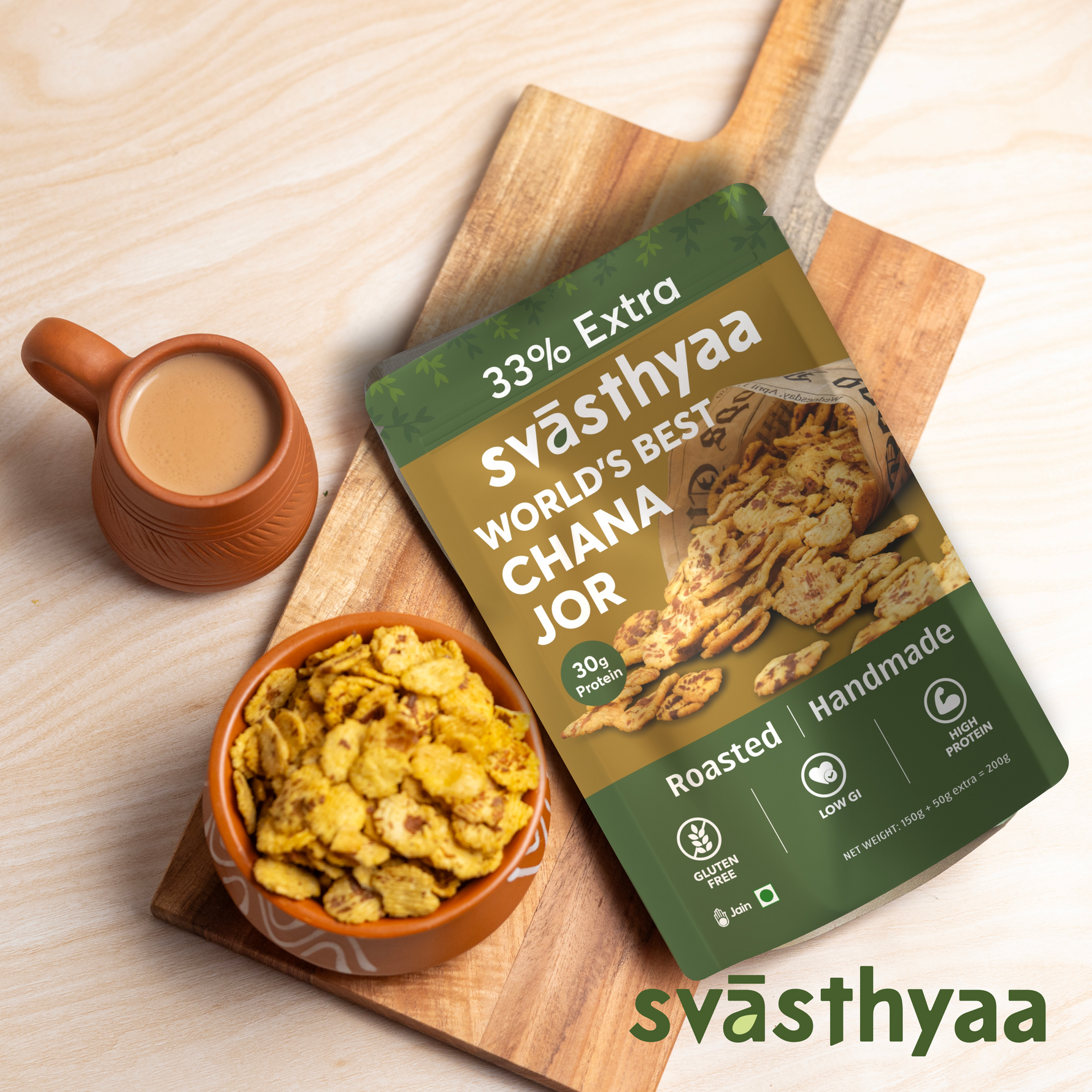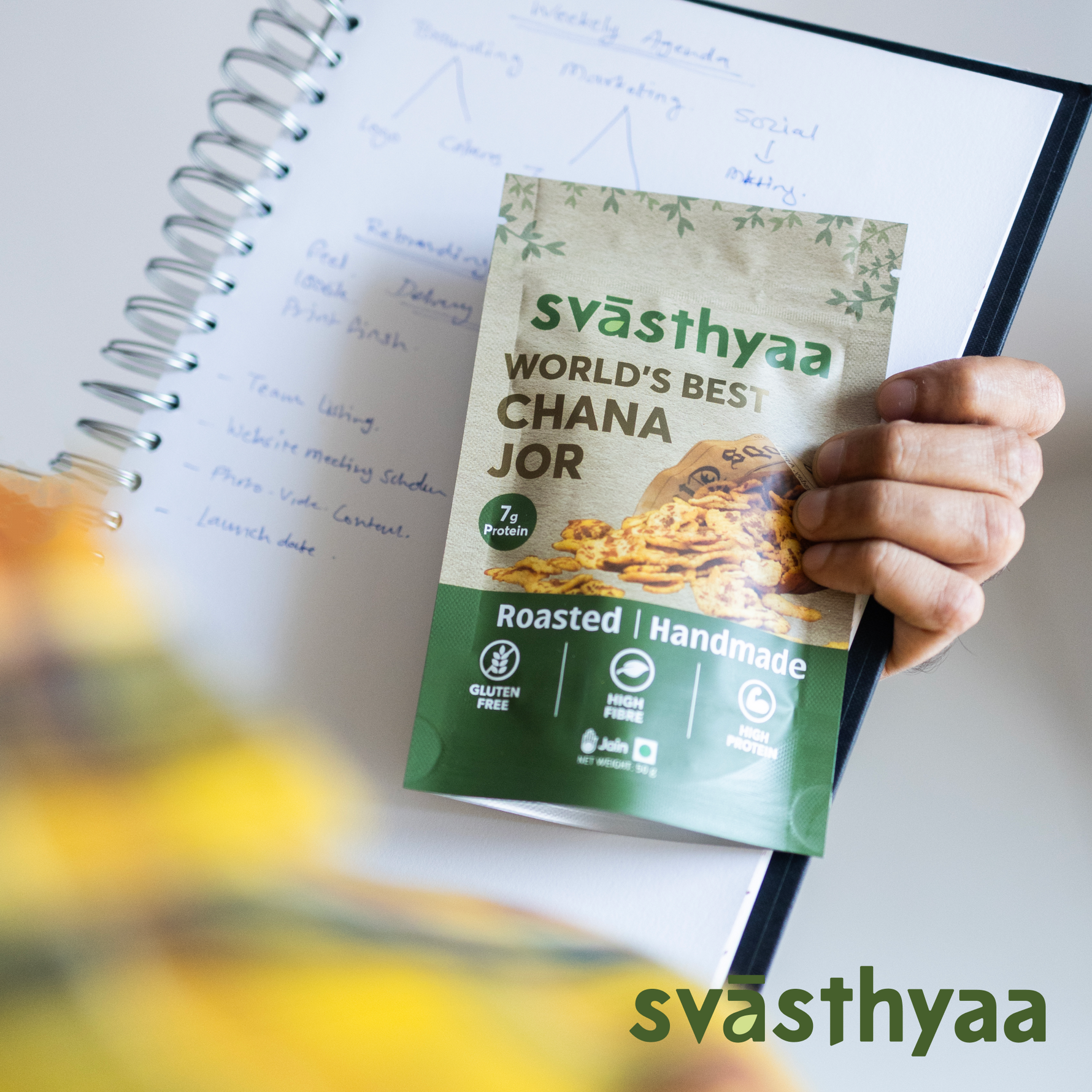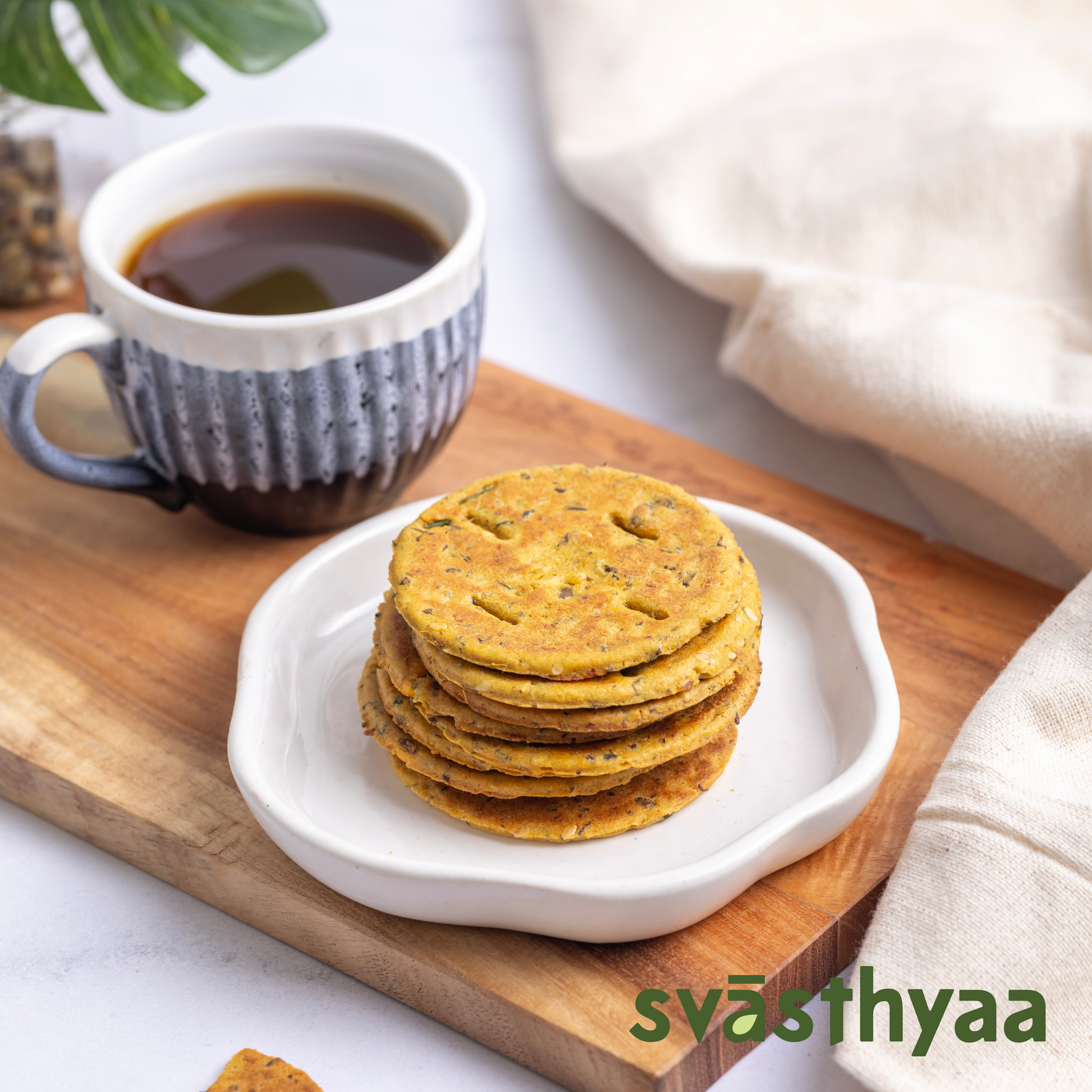Svasthyaa Organics
Where ancient culture meets modern health in every delicious, nutritious snack.
Home
Pincode
Pincode
×
Pincode Availability Checker
Blog posts

Our very own traditional delight CHANA JOR
by Pranav Gadhe on May 14, 2024
In the realm of healthy snacks, Chana Jor stands out as a time-honored delicacy, redefining the essence of nutritious munching. This traditional snack, originating from ancient culinary traditions, is much more than a mere nibble. What sets it apart? Its commitment to purity and health: Chana Jor boasts a composition free from palm oil, maida, and added sugars. Crafted for the health-conscious, it is entirely gluten-free and vegan, adhering to the strictest dietary standards. Each flake is meticulously hand-roasted and hand-pressed, ensuring a burst of natural flavor and wholesomeness. A simple, unadulterated treat, Chana Jor is a great choice for anyone looking for snacks that are both tasty and nutritious.
Health Benefits
Chana Jor is not just a snack; it's a powerhouse of nutrition, tailored for the modern-day health enthusiast. Its high protein content is a boon for those seeking muscle health and overall well-being, making it a favorite among fitness freaks and weight watchers. The protein in Chana Jor provides sustained energy, vital for active lifestyles.
For those navigating the challenges of diabetes, Chana Jor emerges as a friendly ally. Its low glycemic index ensures a minimal impact on blood sugar levels, making it a safe and satisfying option. Moreover, its gluten-free nature is a blessing for individuals with gluten intolerance or celiac disease, providing a snack that's as safe as it is delicious.
By avoiding common health culprits like palm oil, maida, and added sugars, Chana Jor aligns perfectly with a health-conscious diet. Its natural composition supports a wholesome lifestyle, helping maintain blood sugar levels, and aiding in weight management effectively.
Culinary Versatility
The magic of Chana Jor extends beyond its health benefits, venturing into the realm of culinary creativity. This versatile snack can seamlessly transform everyday dishes into delightful and nutritious meals. Sprinkle these roasted flakes over your salad for an added crunch, or enjoy them as a stand-alone snack – a guilt-free indulgence to satiate those midday hunger pangs.
But Chana Jor's potential doesn’t stop there, Chana Jor, made from flattened black chana or black chickpea, is a versatile ingredient that has found its way into various local street delights across different regions, each offering a unique taste experience. From the tangy zest of saundal, a popular South Indian snack rich in flavors and spices, to the irresistible masala puri chaat, where Chana Jor adds crunch and nutrition to a mix of spicy and tangy ingredients, it's clear that this humble legume can be transformed into a pyramid of mouth-watering dishes. These local delicacies not only showcase the culinary diversity of our regions but also highlight how a simple ingredient like Chana Jor can be elevated into something extraordinary.
For the creative cooks, Chana Jor can be the base for innovative snacks and savories. From spicy Chana Jor chaat to wholesome energy balls, its adaptability in various recipes caters to every palate, proving that healthy eating doesn't have to be boring.Conclusion
Chana Jor is more than just a snack; it's a testament to the harmonious blend of tradition, health, and flavor. Its unique combination of being hand-roasted, hand-pressed, free from palm oil, maida, and sugar, and its status as a gluten-free and vegan snack, makes it an ideal choice for a diverse range of dietary preferences. Whether you’re a fitness enthusiast, someone managing diabetes, a gluten-sensitive individual, or simply a health-conscious consumer, Chana Jor offers a nutritious solution to your snacking needs.
By incorporating Chana Jor into your diet, you're not only opting for a delicious snack but also embracing a lifestyle choice that prioritizes well-being and taste in equal measure. It’s a step towards a healthier, more balanced lifestyle, proving that good health and great taste can indeed go hand in hand. Embrace the goodness of Chana Jor and let it be your partner in your journey towards a healthier life.

Reviving the Legacy of Chana Jor: A Nutritious Comeback
by Pranav Gadhe on May 14, 2024
Chana Jor, an ancient Indian snack, once a staple in every household, is making a striking comeback, thanks to SVASTHYAA R&D team’s innovative approach to traditional snacking. Known for its delightful crunch and rich flavor, Chana Jor is not just a snack; it's a nutritious treasure trove, packed with health benefits. SVASTHYAA is leading the charge in reviving this traditional favorite, infusing it with modern health standards.
Nutritional Profile of Chana Jor
Chana Jor, made from bengal gram or kala chana, is a protein powerhouse. It's rich in fiber, minerals like iron and magnesium, and vitamins that are crucial for overall health. Its high protein content makes it a preferred snack for fitness enthusiasts, while its fiber richness aids in digestion and promotes a feeling of fullness, aiding in weight management.
SVASTHYAA's Health-Forward Approach
SVASTHYAA has transformed Chana Jor into a snack fitting the health demands of the contemporary world. Their Chana Jor is organic, ensuring that you're consuming a product free from harmful pesticides and chemicals. It's also gluten-free and made without maida, making it a safe and nutritious option for those with gluten sensitivities or celiac disease.
Importantly, SVASTHYAA’s Chana Jor contains no palm oil and zero sugar, aligning with a heart-healthy and diabetic-friendly diet. The hand-pressed and roasted technique used in its preparation not only enhances its flavor but also maintains its nutritional integrity, ensuring that every bite is as healthy as it is delicious.
Taste Meets Tradition and Health
SVASTHYAA’s initiative goes beyond just providing a healthy snack; it's about reintroducing the rich culinary heritage of India to modern palates. Their Chana Jor is a perfect blend of traditional taste and contemporary health consciousness. It's a snack that satisfies cravings while nourishing the body.
Conclusion: A Snack for Today’s Health-Conscious Consumer
With SVASTHYAA’s Chana Jor, the forgotten delight of this ancient Indian snack is reborn. It's a testament to how traditional snacks can be innovatively reimagined to suit today’s health-focused lifestyle. This is not just a snack; it's a nutritious journey, taking us back to our roots while keeping our health in the forefront.

Sprouted Moong Snacks – The Indian Superfood
by Pranav Gadhe on May 14, 2024
In the realm of health-conscious eating, sprouted moong has emerged as an Asian superfood, celebrated for its remarkable nutrient profile. SVASTHYAA, aligning with this health trend, has skillfully crafted a range of sprouted moong snacks that tick all the boxes for today's wellness-focused consumer: organic, gluten-free, no maida, no palm oil, zero sugar, diabetic-friendly, and rich in protein.
A Nutrient Powerhouse
Sprouted moong beans are a treasure trove of nutrition. The sprouting process enhances their nutrient content, making them richer in protein, vitamins, and minerals, while being easily digestible. These tiny green wonders are known for their versatility and are a staple in Asian diets for good reason.
SVASTHYAA's Commitment to Health
At SVASTHYAA, the focus is on delivering snacks that are not only healthy but also delicious. Their sprouted moong snacks are a testament to this commitment. Organic and gluten-free, these snacks cater to a wide range of dietary preferences and restrictions. They're meticulously prepared without maida or palm oil, ensuring purity and quality in every bite.
Zero Sugar, Diabetic-Friendly Snacking
One of the key attributes of SVASTHYAA's sprouted moong snacks is their diabetic-friendly profile. By avoiding processed sugar, these snacks offer a guilt-free snacking experience, perfect for maintaining stable blood sugar levels. This makes them an ideal choice for health-conscious individuals and those managing diabetes.
A Protein-Rich, Nutritious Choice
Protein is vital for numerous bodily functions, and SVASTHYAA’s sprouted moong snacks are a great way to get this essential nutrient. Perfect for fitness enthusiasts and anyone seeking a balanced diet, these snacks provide sustained energy and aid in muscle recovery and growth.
Conclusion: A Snack for the Future
SVASTHYAA’s sprouted moong snacks are more than just a nod to traditional Indian cuisine; they represent a fusion of taste and health, suitable for modern lifestyles. Embracing these snacks is a step towards a healthier, more nourishing diet, rooted in the wisdom of the past but perfectly tailored for today's nutritional needs.







